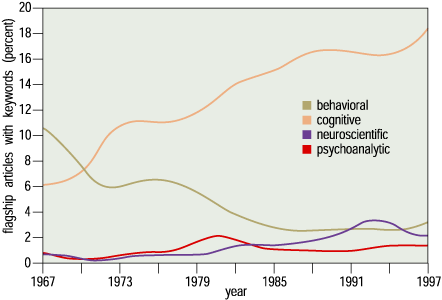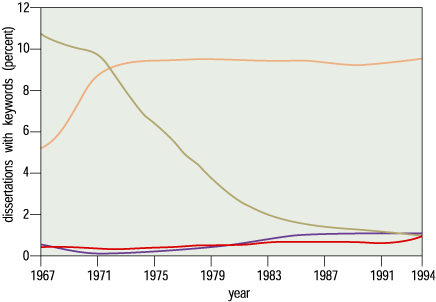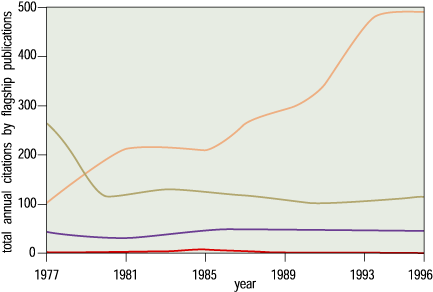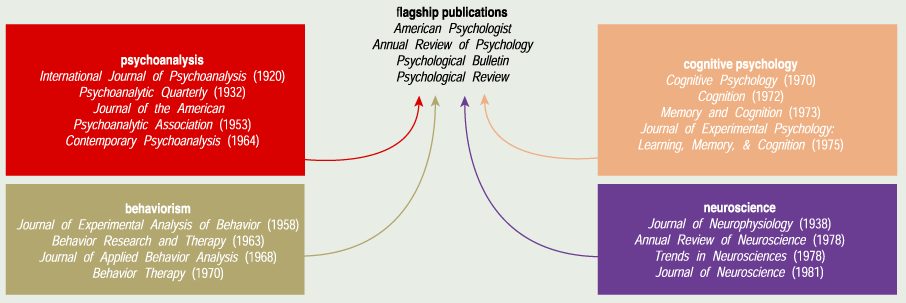Psychological Science at the Crossroads
By Richard Robins, Samuel Gosling, Kenneth Craik
An empirical comparison of the field's orientations
An empirical comparison of the field's orientations

DOI: 10.1511/1998.31.310
As scientists, we're often asked what's "hot" in our field and what's not—what ideas are waxing or waning in prominence. Although this question may stimulate lively conversation, the answers are rarely informative and often misguided. Unfortunately, decisions about funding, hiring and so on are often based on decision-makers' personal views of trends in a given field. Clearly such important decisions should be guided by empirical evidence rather than by speculation.
Unfortunately this is often not the case. In our field, psychology, debates among established schools of thought maintain a continuing tug-of-war between prevailing and competing ideas, providing fertile ground for speculation. Since the birth of scientific psychology over 100 years ago, four major schools have competed to become the predominant model for understanding human behavior: the psychoanalytic, the behaviorial, the cognitive and the neuroscientific. If you ask a psychologist from one camp or another which is the prevailing school of thought, you are likely to get different answers. This raises troubling questions. Is psychology a splintered field, or one moving toward an overarching orientation that would tie together its diverse threads? If so, what orientation is that—is there an integrating scientific theory emerging?

The question generally gets quickly rephrased in terms of the major schools. The psychoanalytic perspective, first, has recently come under fire. Time and other popular magazines have asked, "Is Freud dead?" Within scientific journals, however, debate continues over the prominence and relevance of Freudian ideas to contemporary psychological research.
Another popular contention is that the cognitive perspective now dominates psychological science, having prevailed over the Skinnerian behaviorist tradition. Nobel laureate Roger Sperry has claimed that this "cognitive revolution" is "widely recognized and well-documented . . . and appears to constitute a true shift of paradigm" (Sperry 1988). Others have come to the defense of the behaviorist school; in a 1994 American Psychologist article, Kurt Salzinger declared: "Although I have conducted no study, prepared no in-depth interview, nor even any shallow survey of opinions, I do contend that behavioral analysis is alive and kicking and that I for one knew it all along." Finally, psychologists are currently debating whether the emergence of the neuroscientific perspective (as we wrap up what Congress designated "The Decade of the Brain") will transform the field, perhaps turning psychology into a subfield of biology.
So what's really going on in psychological science? We decided to take a look at the evidence. We found that some widely held beliefs about trends in psychology stand up to empirical scrutiny, but others do not. We did not find clear movement toward a unifying idea, or toward integration of the new work in neuroscience with mainstream thought in psychology.
We thought a statistical examination of literature in the discipline would allow us to examine trends over several decades in the prominence of the four major schools of psychology. Because prominence is a tricky construct to measure, we used three different approaches to take a snapshot of the period 1967–95. We looked at the subject matter of articles published in the most influential (or "flagship") psychology publications, the subject matter of dissertations and the degree to which the flagship publications cite articles from each school's core journals. These three approaches, as it turned out, paint strikingly similar portraits of the recent history of psychology, providing converging evidence for the following conclusions.
First, we learned that the psychoanalytic school has not fared well over the past few decades. Scientific psychologists have paid little attention to research published in the preeminent psychoanalytic journals, and a psychoanalytic focus has been virtually nonexistent in either flagship publications or dissertations. Thus, contemporary psychoanalytic research is not being assimilated directly into mainstream scientific psychology.
This does not mean that "Freud is dead," but rather that his presence is felt indirectly. Indeed, many of Sigmund Freud's basic ideas—for example, that unconscious processes influence behavior and that early-childhood experiences influence adult development—have become incorporated into the foundation of psychology as a science. More generally, psychoanalytic thought continues to be influential in the broader intellectual community, shaping scholarship in the humanities (dissertation titles such as "Kafka's Hunger artist and the psychoanalytic approach to literature" are not uncommon) and other social sciences.

Linda Huff

Linda Huff
Second, confirming another popular perception, we discovered that the past few decades have not been kind to the behaviorist school. Despite claims to the contrary, behavioral psychology, and its associated concepts of conditioning and reinforcement, has been on the decline in psychological science. (The one apparent exception to this decline was a flurry of attention to behaviorism in 1992, which closer inspection revealed was the result of articles commemorating B. F. Skinner upon his death.) During the 1970s, the prominence of the behavioral school gave way to the ascension of the cognitive school. However, as was the case for psychoanalysis, behavioral concepts and methods continue to be used by psychologists to describe and study human behavior.
Third, we found that the cognitive school has overtaken the behavioral school as the most prominent of the four, supporting the claim that there has been a "cognitive revolution." Our two subject-matter analyses place the ascension of cognitive psychology over behavioral psychology about a decade earlier (circa 1971) than our analysis of citation trends (circa 1979), suggesting that the citation index may take longer to detect scientific trends.
What accounts for the cognitive school's rise to prominence? The central driving force is probably the computer revolution. Computers provided scientists with a new metaphor for conceptualizing how the mind works, one based on information processing and associated concepts of storage, retrieval, computational operations and so on. Perhaps equally important, computers paved the way for the development of new methods for the scientific measurement of mental processes (for example, highly controlled presentation of stimuli, reaction times, dichotic listening, simulations of cognitive processes and brain-imaging techniques). However, the cognitive school's dramatic rise to prominence shows some sign of abating; its trajectory in two of the three indices had leveled off by 1990.
Fourth, and perhaps surprising, we found little evidence that mainstream psychology is paying increasing attention to neuroscience research. This finding contradicted our intuitions about the field and intrigued us. We searched for further evidence of neuroscience's prominence within psychology. First we expanded the subject-matter analyses to include a broader range of terms ("brain," "MRI" or "PET," for example). Second, instead of restricting our citation analysis to the four core neuroscience journals, we examined citations by the flagship publications to articles published in any journal with "neuro" or "brain" in the title. In neither case did we find more than a minor upward trend for neuroscience.
What, then, accounts for the widespread belief in the growth of neuroscience within psychology? One possibility is that our three indicators of prominence have a lag time, and they will detect the increasing prominence of neuroscience over the next decade or so. Another possibility is that neuroscience is growing in importance, but not within psychology.

Linda Huff
Indeed, membership in the Society for Neuroscience has skyrocketed since it was founded in 1970, and neuroscience journals have been proliferating rapidly over the past several years. Moreover, when we analyzed citation trends in the journal Science we found a marked increase in citations to the four core neuroscience journals beginning in the late 1980s; in contrast, journals from the other three schools of psychology were rarely if ever cited. Finally, the core neuroscience journals are among the most frequently cited scientific journals when citations from all sources (not just psychology publications) are considered; in fact, two of the journals—the Annual Review of Neuroscience and Trends in Neurosciences—have citation rates comparable to Science and Nature. Clearly neuroscience is rising in prominence but, according to our measures, not within mainstream psychology. At this point, neuroscience seems to be established more centrally in biology than in psychology.
Writing to the general psychological community, the eminent neuroscientist Larry Squire recently argued, "As the next century approaches, one should celebrate and encourage the increasing partnership between psychology and neuroscience." We agree, but unfortunately we have yet to find clear empirical evidence for the emergence of such a partnership. One of the lessons of our survey is that psychologists need to work harder to integrate neuroscience into their field. Neuroscience is still defining its borders, and the degree to which it will overlap with psychology remains to be seen. We believe psychological science is at a crossroads in its development as a science. Unless it continues to build on new discoveries and methods in neuroscience, it risks simply losing neuroscience to the biological sciences. In our opinion, the brain and behavior need to be studied in tandem. Psychology should not let the opportunities presented by neuroscience slip away.

Linda Huff
In the recent history of psychological science, schools have risen and fallen from prominence in turn. What lies down the road? The field appears to be dividing into increasingly specialized camps—attention, memory, language—that may eventually render broad classifications such as "cognitive psychology" obsolete. At the same time, psychology seems to be coagulating around more general scientific orientations that cut across traditional fields of study; cognitive science combines psychology, linguistics, computer science and philosophy. Will psychology find a way to tie together its diverse threads? Perhaps an integrative perspective such as evolutionary theory will achieve this goal and rise to prominence. Or, in the most distant future, an even broader perspective such as complexity theory may revolutionize the field. Speculation and debates about scientific trends will continue to go unfettered by empirical evidence and echo through the halls of academia. The conclusions reached in these debates have wide-ranging implications for funding, hiring and ultimately how scientists study human behavior.
Click "American Scientist" to access home page
American Scientist Comments and Discussion
To discuss our articles or comment on them, please share them and tag American Scientist on social media platforms. Here are links to our profiles on Twitter, Facebook, and LinkedIn.
If we re-share your post, we will moderate comments/discussion following our comments policy.